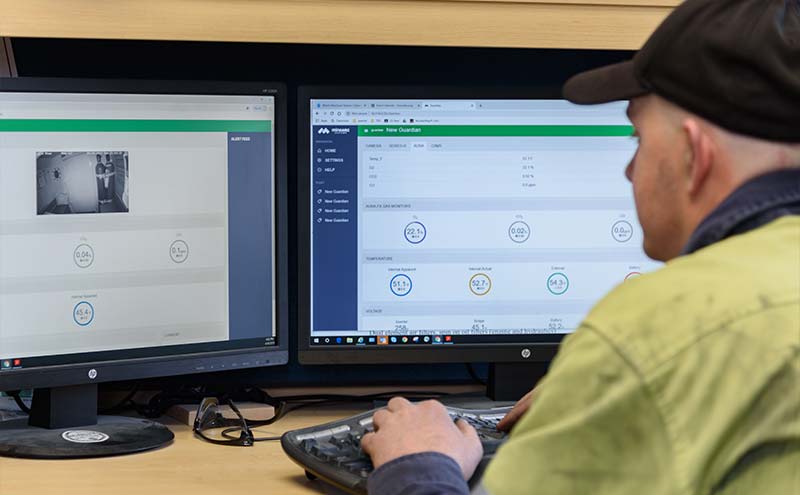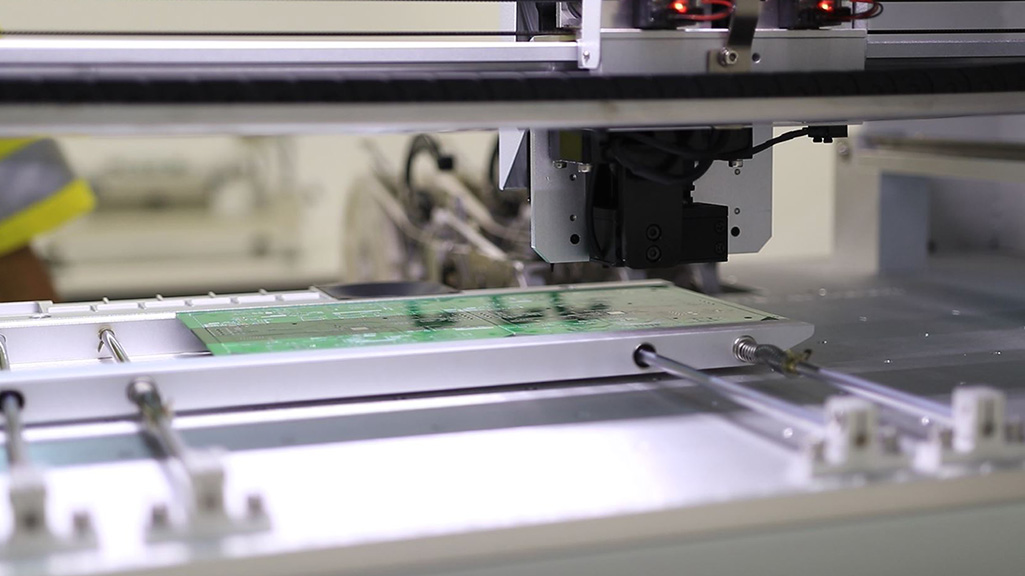Remote monitoring and analytics to refuge chambers are valuable during an emergency or daily operations. Data transferred from the equipment within the refuge bay identifies its emergency-preparedness.
Remote Monitoring of a Refuge Chamber
Real-time Data in Emergency Situations
During a hazardous event that triggers an evacuation and use of a refuge bay, monitoring the use and wellbeing of individuals inside and the operating systems can significantly assist with the emergency response plan.
By connecting a refuge chamber to an underground network, available data aids ERT’s to prioritise rescue operations, lets above ground operators communicate with personnel inside and provides continuous insight into the circumstances for quick, educated action. For example, one Australian underground mine recently used GuardIAN Refuge Chamber Monitoring (GuardIAN RCM) to account for underground personnel during a truck fire. The site monitored the video feed through the GuardIAN RCM dashboard.
GuardIAN Connect is the collective suite of products used to provide an underground network using a coaxial cable that provides power and data.
Real-time Data for Daily Operations
As with all machinery, a refuge bay requires regular maintenance and servicing.
While not the primary motivator, additional benefits to service and maintenance procedures can reduce costs and improve safety underground. These benefits extend to proactive and reactive management of refuge chambers.
Refuge chambers are a necessity in underground mines. They are required in all operating sites, enforced by industry regulations across Australia and internationally. Non-compliance can result in sections of the mine being shut off if a refuge is deemed unfit, impacting productivity. The known risk of underground operations is the main reason why operations must cease in an area where a refuge chamber is not operational.
Remote monitoring can improve maintenance response time and mitigate the loss of production and ensure the safety of personnel underground. External data analysis above ground or on portable devices can provide essential crew members with crucial information to troubleshoot faults promptly.
Real-time access to relevant information about a refuge chambers status, faults and usage can reduce the cost and time involved with maintenance. MineARC’s GuardIAN Refuge Chamber Monitoring is a plug-and-play system explicitly designed for refuge chambers. The system provides service technicians with the knowledge and technical details needed to complete their job effectively and efficiently, consequently underground operations and improving safety.
For example, push notifications can be enabled to send fault codes notifying the service personnel to take corrective action. These notifications can relieve time pressures associated with reactive maintenance and reduce human error through incorrect diagnosis and delayed reporting.
The bottom line is that maintenance has to occur. Equipping technicians with the tools to complete their roles efficiently and accurately delivers an advantage by reducing costs and delays with repairs.
The below scenario outlines actions taken when faced with a simple electrical fault within a refuge chamber, demonstrating the time-saving nature of remote monitoring systems compared to pass-by diagnostics.

Using GuardIAN Refuge Chamber Monitoring
Timeline Scenario: Electrical Fault
Example fault scenarios during Day-to-Day Operations
Actions are in process to correct the fault. An electrician attends the scene as outlined in the following scenarios.
| Time | Without GuardIAN RCM | Time | With GuardIAN RCM |
| 9:00 AM | Red and green flashing light is triggered on the front of the chamber, indicating a fault within the chamber. | 9:00 AM | Red and green flashing light is triggered on the front of the chamber, indicating an error within the chamber. |
| 9:30 AM | This remains unreported; this may be due to several reasons: – Ignored – Unseen – Seen, but not reported | 9:00 AM | GuardIAN RCM triggers alert, and a push notification specifying fault code goes to the Service department. |
| 10:00 AM | Someone notices the red light and reports the anomaly to the Control room operator; this is transferred to the site electrician. | 9:05 AM | Recognition of fault type, Electrician takes note – non-critical repair |
| 10:02 AM | Electrician takes note | 9:15 AM | Electrician source spare parts required for fault code
|
| 10:20 AM | Electrician attends the scene and assesses the situation. Various diagnosis and actions are outlined in the following scenarios. | As per Run Sheet | When underground as part of a general routine run sheet |
| 10:50 AM | Deemed ‘non-critical’ | TBA | The refuge chamber is emergency-ready and fit for purpose |
| 11:30 AM | Return to the surface for spare parts | ||
| As per Run Sheet | Head back underground to repair the chamber. | ||
| TBA | The refuge chamber is emergency-ready and fit for purpose |
Time | Without GuardIAN RCM | Time | With GuardIAN RCM |
9:00 AM | Red and green flashing light is triggered on the front of the chamber, indicating a fault within the chamber. | 9:00 AM | Red and green flashing light is triggered on the front of the chamber, indicating an error within the chamber. |
9:30 AM | This remains unreported; this may be due to several reasons: – Ignored – Unseen – Seen, but not reported | 9:00 AM | GuardIAN RCM triggers alert, and a push notification specifying fault code goes to the Service department. |
10:00 AM | Someone notices the red light and reports the anomaly to the Control room operator; this is transferred to the site electrician. | 9:05 AM | Recognition of fault type, Electrician takes note; refers to manual for additional troubleshooting. |
10:02 AM | Electrician takes note | 9:15 AM | Electrician source spare parts required for fault code.
Immediately heads underground to repair the chamber. |
10:20 AM | Electrician attends the scene and assesses the situation. Various diagnosis and actions are outlined in the following scenarios. | 10:00 AM | The refuge chamber is emergency-ready and fit for purpose |
11:00 AM | Return to the surface for a spare part. |
|
|
11:30 AM | Head back underground to repair the chamber. |
|
|
12:30 AM | The refuge chamber is emergency-ready and fit for purpose. |
|
|
Time | Without GuardIAN RCM | Time | With GuardIAN RCM |
9:00 AM | Red and green flashing light is triggered on the front of the chamber, indicating a fault within the chamber. | 9:00 AM | Red and green flashing light is triggered on the front of the chamber, indicating an error within the chamber. |
9:30 AM | This remains unreported; this may be due to several reasons: – Ignored – Unseen – Seen, but not reported | 9:00 AM | GuardIAN RCM triggers alert, and a push notification specifying fault code goes to the Service department. |
10:00 AM | Someone notices the red light and reports the anomaly to the Control room operator; this is transferred to the site electrician. | 9:05 AM | Recognition of fault type, Electrician takes note and notifies mine control of tag out. |
10:02 AM | Electrician takes note | 9:15 AM | Electrician place urgent delivery order of spare parts required for fault code
|
10:20 AM | Electrician attends the scene and assesses the situation. Various diagnosis and actions are outlined in the following scenarios. | 9:25 AM | Head back underground to tag out the chamber. |
11:00 AM | Tag on person. Notify mine control. | 9:50 AM | Refuge chamber is tagged out until the required part/s are delivered and repairs complete. |
11:20 AM | Tag out the chamber. |
|
|
12:00 PM | Refuge chamber is tagged out until the required part sourced and repairs complete. |
|
|
1:00 PM | Organise the delivery of required spare parts |
|
|






